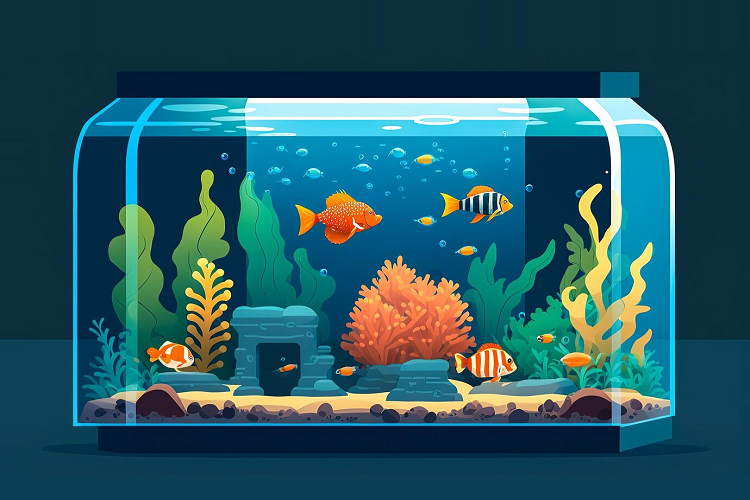Everyone loves a beautiful aquarium. Whether it’s a simple one for the home, a massive centerpiece for a restaurant, or an elegant one for an office, every aquarium will always draw in people to marvel at the fish inside. Though they’re certainly a work of beauty, aquariums are a very technical business from the inside and out.
Tops to Start an Aquarium Business
If you’re passionate about marine life and bringing the fascination of aquariums to customers and businesses, we’ll show you how to start an aquarium business yourself in this post.
Do Some Research
As any entrepreneur will tell you, starting a business is hard. Especially in the beginning building phase, creating a business requires an extraordinary amount of time and effort. Make sure you’re in it for the long haul and have a clear vision. It won’t be worth it if it’s only a pet interest and not something you’re very invested in.
Starting an aquarium business is also risky, too.
- Will you have the capital or access to capital to start one?
- Do you understand the aquarium market and have the business acumen or experience to help you succeed?
- What will you do if the business succeeds, or if it fails?
These are all important questions to ask yourself early because the answers will affect what happens later when you start the business.
Structuring the Business
In the beginning, creating an aquarium business is just like any other one. You’ll need to get a business license and sales tax license, and you might also need a license for live fish.
We recommend consulting with a qualified business lawyer and certified public accountant. This is not just for navigating the legalese of the necessary licenses but for helping structure the company.
While it might be harder, if you can find a lawyer and CPA with experience in the fish or aquarium industries, it’s even more ideal.
Create Your Business Plan
“Aquarium business” is a very large umbrella term. There are a lot of moving parts in aquariums–the aquarium tanks, the fish inside them, the infrastructure and pumps to run them, as well as the decor, fish food, and chemicals needed.
- Will you enter the industry by focusing on a niche product?
- Will you use your connections to start selling and distributing exotic fish species?
- Would you start offering bespoke aquarium tanks?
Each one of these models requires completely different approaches. For example, you could probably license your special blend of fish food, but you’d need to get into contact with a factory if you want to sell your own aquarium tanks.
If you’re unsure how to execute your business plan, it might be a good idea to research your competitors and see how they do–see how their staff interacts with customers, how they decorate and arrange the store, and if they ever launch any sales or promo events. As they say, imitation can be the highest form of flattery.
Whatever your business is trying to sell, the product must be the protagonist. If you’re going to be selling custom-made aquariums, make sure that they’re quality and built to last. If you’re selling fancy fish tank decorations, emphasize that they’re handmade and sourced from quality and sustainable materials.
Set Up Shop
This could be literal or figurative. If you like (and have the money to do so), you could absolutely open up your own shop. Or you could simply open up a store on the Internet, and offer your products online. There’s nothing stopping you from doing both too, and we always recommend having an online presence if you can handle the shipping and packing.
Having a brick-and-mortar store may be more expensive, but gives your customers a chance to fully appreciate the product in person. Aquariums are naturally a very eye-catching thing, so displaying your product (preferably in an actual, functioning aquarium!) is a great way to help it sell itself.
If you’re selling highly visual items, such as bespoke aquariums, exotic fish, or custom-made decorations, this is a great way to attract foot traffic. If there are competing pet stores or aquarium vendors in the area, pay them a quick visit and get a feel for the place.
An online store is also worthy of your attention. If you’re trying to sell aquarium equipment and hardware, which many pet stores and smaller stores may not have, it might be more pragmatic to sell online and deliver directly to consumers.
Chances are you’ll save money on shipping smaller parts, compared to larger, heavy, bulky aquarium tanks. Even if you aren’t very tech-savvy, you can easily set up an Internet store with simple software solutions from WordPress, Shopify, Amazon, and more.
Advertise
Even a killer aquarium product might not sell itself right off the bat. And that’s okay–don’t be discouraged! You might need to kick it off with some advertising first.
Advertising can be whatever you make of it. It can be as simple as proudly displaying your coolest custom tank in the window and letting customers come to ogle.
If you’re savvy with social media, create a business account on Instagram, Facebook, TikTok, and LinkedIn, and start creating content–there are a lot of sources on YouTube and these social media platforms that show you how to create viral content that translates into sales. The best part is these platforms are free!
If you have the money, you can always outsource the marketing and advertisements to an agency or marketing professional. They can create quality content quickly for your company to help you garner attention more quickly. If you can find an agency that’s helped clients in the aquarium or fish fields, that’s an added bonus that’s sure to add to your bottom line.
Either way, you don’t need a vast budget to spread the word. Remember that you can capture a lot of attention simply by being creative and networking. See if you can connect with your local schools or college’s marine or biology classes and clubs.
Set up a stall at trade shows, throw an open house party with fun decor, get in touch with local fishing or aquarium enthusiasts clubs and post in those Facebook groups. And don’t underestimate the power of taking out an ad in the local newspaper.
Offer Quality Service
Make sure that whatever you sell, you make the customer feel welcomed and valued. It doesn’t matter how great the product is if the customer is put off by bad customer service.
So, make sure that your employees understand that too. Hire workers that are interested in fish, aquariums, and aquaculture so their enthusiasm radiates through to the customers.
Take the time to train them–instruct your employees on how to greet customers who walk into or call the store, how to be helpful and informative (without hovering!) when customers are browsing, and always have the customer’s interest when solving a problem.
This applies to online stores, too! When stocking inventory for your online store (or even a brick-and-mortar one), try to buy the largest amount of product you can; buying wholesale helps you stock more products, so you can quickly replace items if there’s ever something a customer needs or wants to be replaced.
In addition, buying wholesale and in bulk often means you can get products at a lower price per unit, helping you to maximize your product. Add software to your website that emails customers a “thank you” when they make a purchase. It will then follow up by asking them to give any feedback.
The bottom line is there’s nothing fancy to it. Simply care about the customer and make them a priority. Great service might make up for an inferior product (not that yours is inferior!), but a great product will not earn you customer loyalty if they receive inferior service.
Be Open to Feedback and Reflection
We said in the beginning that starting any business is a tough task that requires a lot of patience, effort, focus, and time in order for it to succeed. Part of that patience and effort is involved with acknowledging that you might have to try another way. Even the best-made plans might not always pan out, and you’ll have to go back to the drawing board.
That nifty new aquarium design might not take off with customers, and you’ll have to come up with a new one or get consumers’ opinions to see what went wrong. Or the order of aquarium pumps you placed at an overseas manufacturer might be delayed, and you’ll be faced with the problem of letting customers know–maybe you’ll consider setting up a mass email system to keep them in the loop.
The bottom line is, don’t be discouraged or feel inferior if something doesn’t work on the first try. A lot of business is trial and error, and you’ll get it right if you keep trying.
Don’t be shy about reaching out for help, either–be proactive and reach out for help before you need it. If your friend has an eye for design, offer to buy them lunch in exchange for their input in helping decorate your store.
Hire a consultant when launching your marketing plan, chat with potential marketers to see what products they offer and if they can send samples, and really read through the feedback that customers give you.
The more open-minded and driven to improvement you are, the quicker your business will improve and grow. It’s a long journey, but you can do it!
Some Bonus Tips
Above, we’ve given you the birds-eye view on how to start your aquarium business. The points above are all you need to make it in the industry and help your business thrive. We wanted to provide a couple of more specific, detailed tips that could also be very helpful if they apply to your situation.
What to Look for in an Aquarium Manufacturer
If you’re equipped to produce your own aquariums, that’s great! The reality is, setting up your own production center to produce tanks can be expensive, and takes a lot of capital upfront to build and then more to staff. If you have the capital, and are confident setting up your own factory is the right move for your business, go for it!
The reality is, most aquarium and pet store businesses will be outsourcing their manufacturing to overseas companies, where they can be made more cheaply.
When it comes to selecting a manufacturer, we always recommend choosing one that builds with the highest quality materials; they may cost more, but you’ll save in the long run by having fewer customer returns and higher profit margins.
Always ask for a sample unit–there’s nothing like holding the product in your hands, and it’s a big red flag if a company refuses to send you one.
The Best Fish to Stock for Aquariums
The fish are the wonders that draw curious people over to the aquarium–without them, it’s just a box of Plexiglass. While we believe that all fish are lovely to gaze at, not all of them are easy to raise. If you plan on stocking and selling fish as part of your aquarium business, we have some recommendations.
Know what equipment you’ll be using to house the fish–some do better in certain size tanks. And remember fish can be very territorial so multiple species may require different tanks. With that said, here are our recommendations for the easiest and most profitable fish to breed and stock:
- Dwarf Cichlids
- Discuss
- Plecos
- Clownfish
- Yellow Tangs
Design Tips for Your Aquarium Store
Of course, this only pertains to brick-and-mortar stores. You don’t need to hire an esteemed visual artist to start an aquarium business that will wow your guests. Do make sure that you have good signage that passersby can easily read–a window display with your best fish is even more ideal.
In the store itself, make sure to create “paths” of aquariums, fish, and decor so people will find themselves drifting further into your store as they idly walk, increasing the chances of making a sale.
We also recommend having a centerpiece that becomes the “focal point” of your store. It could be a beautiful, big sculpture of a stingray or some other fish, or your proudest custom-tank design. Anything that’s viewable from the front of the store that customers will want to gravitate to.















